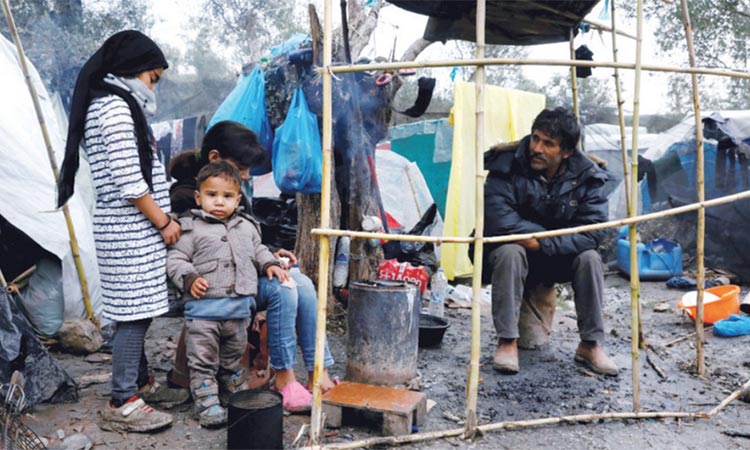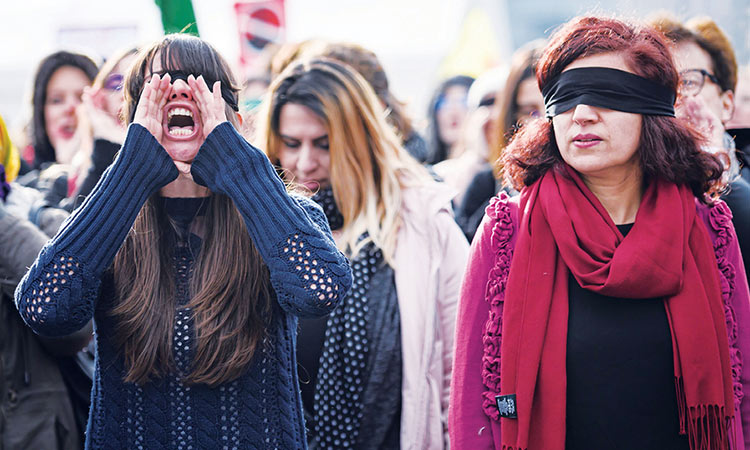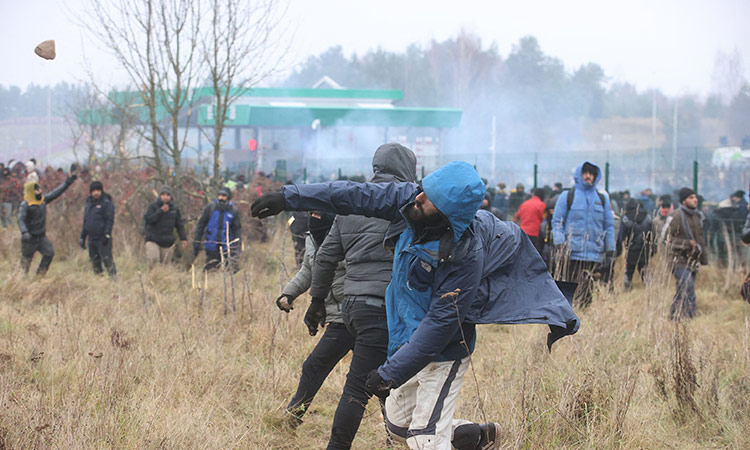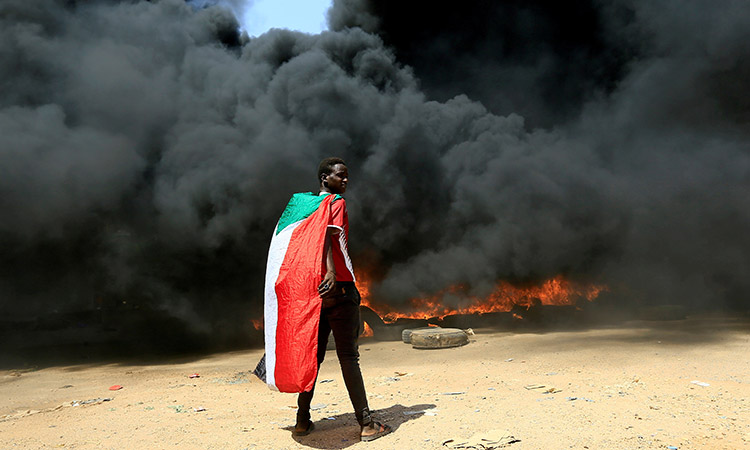Migrants feel the pinch of a crackdown spurred by US
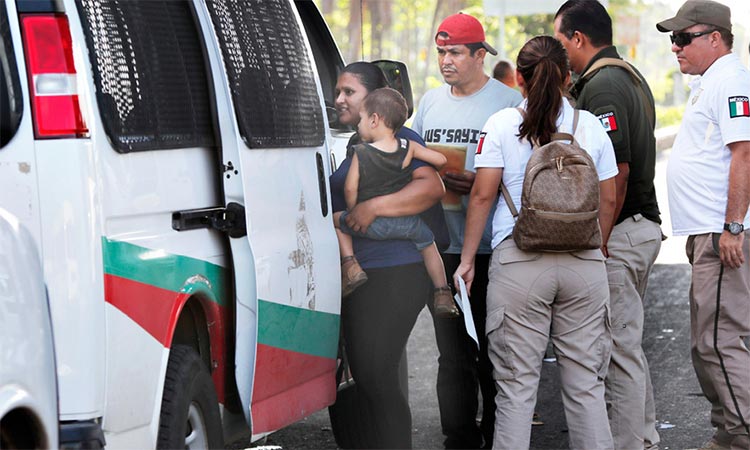
A migrant woman and her child are detained by Mexican immigration agents at a checkpoint in Tapachula, Mexico. AP
Patrick J. McDonnell, Tribune News Service
Long lines of migrants, mostly Central Americans, line up daily outside the Tapachula offices of the refugee agencies of Mexico and the United Nations. Meanwhile, a polyglot throng including people from Africa, Asia and the Caribbean regularly gathers at the local headquarters of the National Institute of Immigration, Mexico’s agency for migrant affairs.
Almost all those seeking help have a common destination — the United States — but they find themselves caught in an expanding Mexican immigration crackdown prompted by US pressure and marooned in this sweltering city in southern Mexico.
They cannot proceed north without risking arrest, so they remain in Tapachula seeking documentation allowing legal travel to the US-Mexico border, more than 1,000 miles away. They say they are fleeing poverty and violence in their homelands.
Maribel Amador and her family were among those gathered on a recent afternoon outside the offices of the Mexican Refugee Assistance Commission. “There is nothing we can do but wait,” said Amador, 36, a Honduran national seeking refugee status in Mexico along with her husband and four children, aged 5 to 14, though the family hopes to make it to the United States. “We can’t move forward without papers.”
A surge this year in migrants from Central America to the United States to levels not seen in at least a decade generated a threat by President Donald Trump to impose tariffs on imports of Mexican goods if Mexico did not move to stem the flow of US-bound migrants traversing the country.
In recent weeks, Mexican authorities have set up immigration checkpoints along the main northbound highway and have been aggressively detaining and deporting thousands of migrants. The law enforcement squeeze seems destined to tighten with Mexico’s vow to deploy some 6,000 National Guard forces to its southern border as part of a deal reached last week with the Trump administration to avert US tariffs.
Mexico has 45 days to demonstrate that the northbound flows of migrants are declining, or the two sides go back to the negotiating table, with Mexico in a weakened position, Marcelo Ebrard, the country’s foreign minister, said Tuesday.
A key question is whether Mexican authorities can overcome long-entrenched corruption that has seen police and immigration agents historically working in cahoots with smugglers, allowing vehicles packed with migrants to continue their journeys.
“You can stop a couple of thousand people in Tapachula, but if (immigration) officers are still letting people go through in buses, because they have deals with the smugglers, it won’t make much of a difference,” said Stephanie Leutert, director of the Mexican Security Initiative at the University of Texas, Austin. “It will require a lot of political will.”
The Mexican strategy is a familiar one: Position checkpoints on the limited number of roads radiating north from the notoriously porous Guatemalan border, which stretches for some 600 miles along jungle, mountain and river terrain. The idea is to bottle up and detain migrants in the south. Mexico also appears to have stepped up enforcement against northbound freight trains, another popular mode of migrant travel.
In March, the Mexican interior minister, Olga Sanchez Cordero, said Mexico planned to create an enforcement containment belt along the Isthmus of Tehuantepec, Mexico’s narrowest point, about 125 miles across from the Pacific to the Gulf of Mexico, to keep the migrant flow from advancing north.
The current scenario in the southern state of Chiapas is far removed from the atmosphere of months past, when tens of thousands of Central Americans — both in organised caravans and in small groups — moved freely through the corridor. Many were quickly granted humanitarian visas as part of Mexican President Andres Manuel Lopez Obrador’s vow to assist migrants. The welcome mat has now been yanked.
Mexican officials reported deporting more than 30,000 foreigners during April and May, almost 70% more than during the same period a year earlier. Police also broke up the two most recent northbound migrant caravans, arresting hundreds.
The enhanced enforcement, however, is unfolding amid what Mexico calls a massive flow of US-bound migrants. The number could reach 900,000 this year — including what Mexican officials say are unprecedented numbers of women and children, mostly from Honduras and Guatemala. Mexico says the numbers represent about double the figures in recent years.
On the main northbound thoroughfare, the Coastal Highway, which parallels the nearby Pacific, immigration agents, federal police and military officers stop northbound buses, cars and minivans, demanding that passengers produce documents. Those lacking papers showing legal status are escorted away to immigration vans.
While Central Americans represent the majority of migrants converging in the shadow of the Tacana volcano, huge numbers of so-called extracontinentales from across the globe also have made the trek.
“I am here now, free today, but I may be arrested today or tomorrow and deported,” said Nesly Simeon, 28, a Haitian national who was among those gathered recently outside the immigration agency in Tapachula, known as Siglo XXI, or 21st Century. “We are here waiting and waiting.”
Many migrants cross illegally into Mexico on rafts crafted of wooden planks and inner tubes across the Suchiate River, which marks the Guatemalan-Mexican frontier. “We mostly see Cubans, Haitians, Africans now,” said Rigoberto Vasquez, known as el conejito, the little rabbit, who has worked the raft enterprise for 35 years, moving both merchandise and people from his muddy riverfront depot, across from a lively outdoor bar-restaurant.
The Mexican clampdown, and the planned National Guard deployment, has yielded protests against a US-style militarisation of Mexico’s southern frontier, which critics liken to Trump’s attempts to build a wall along the US-Mexico border. “If we as Mexicans have rejected the construction of a wall, we cannot turn ourselves into that wall,” the Catholic Conference of the Mexican Episcopate wrote in a statement Monday.
Those with access to cash can turn to smugglers, or coyotes, skilled at circumventing checkpoints — and known for paying off Mexican officials. But smuggling fees can run to $5,000 or more per person for passage to the border, with clients often jammed dangerously into the rear of crowded trucks navigating back roads.
Many people lacking such funds take temporary jobs in Tapachula as laborers, cooks and in other menial positions to help buy food and rent cheap housing. A dozen or more people are often crammed into single rooms, sleeping on mats and blankets.
Migrants gather daily beneath shade trees in Tapachula’s central plaza, waiting for food handouts.

